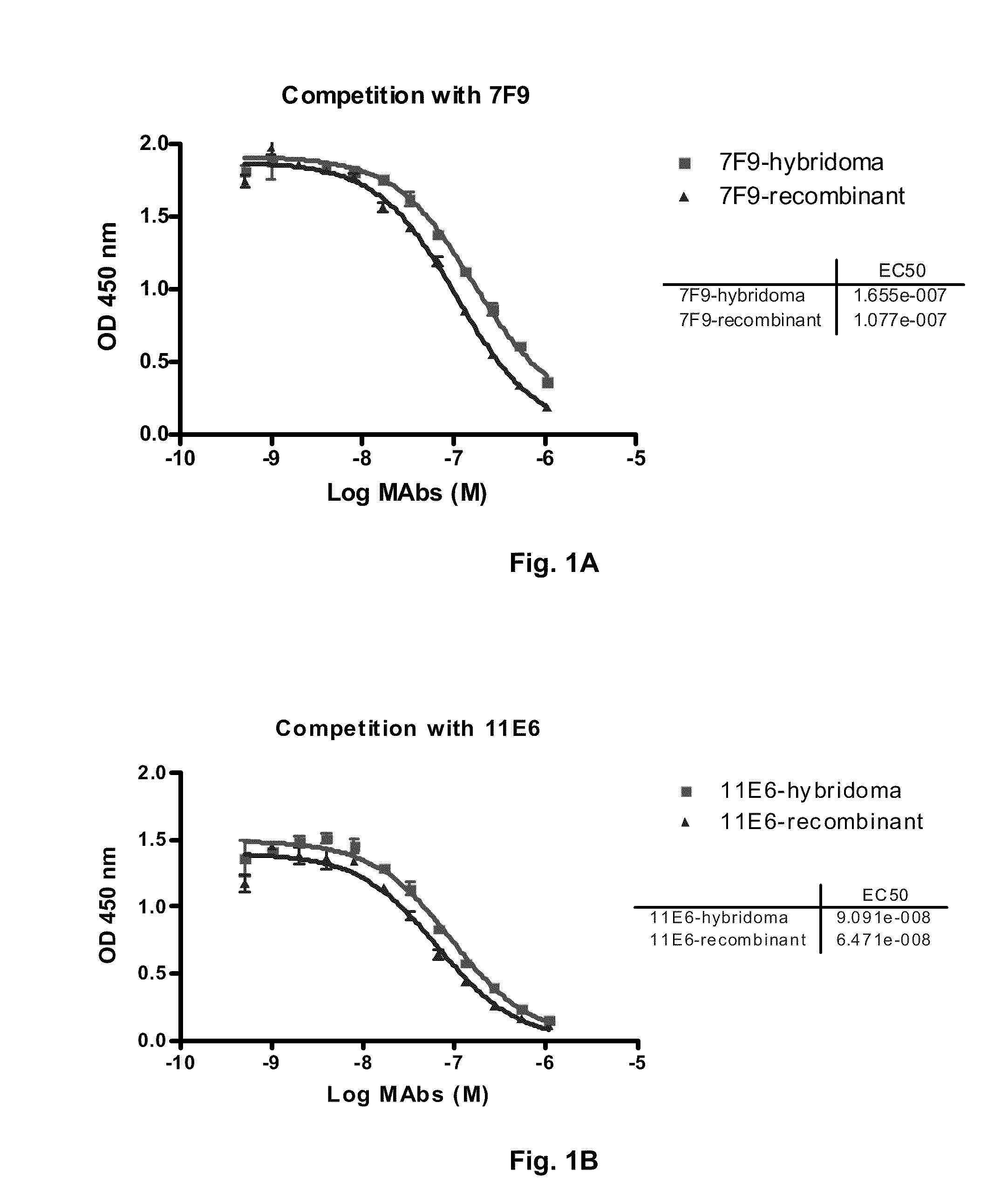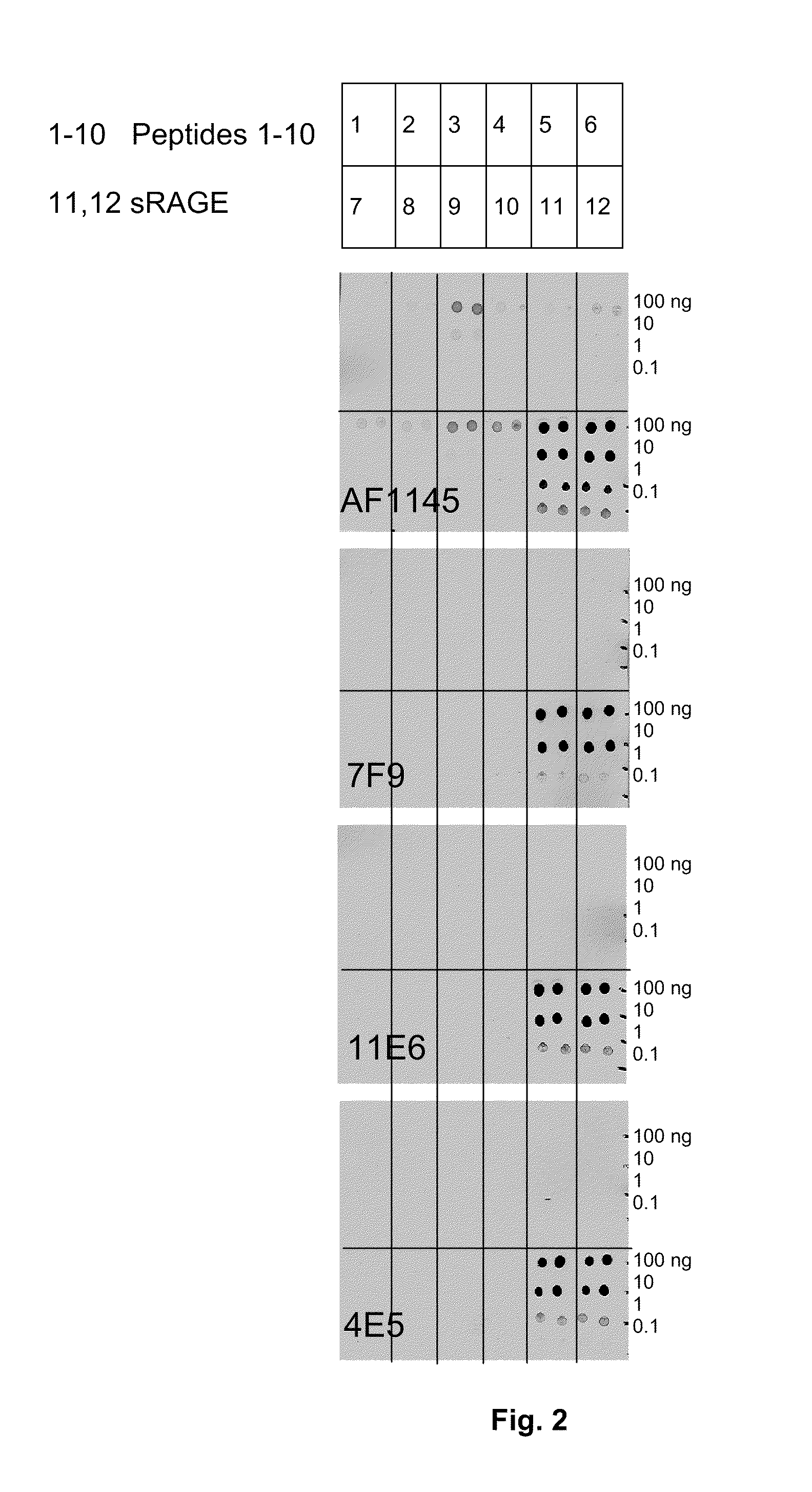Antibodies to receptor of advanced glycation end products (RAGE) and uses thereof
a technology of rage and antibodies, applied in the field of antibodies, can solve the problems that existing polyclonal antibodies generated from animal serum are not suited for human chronic treatment, and achieve the effect of improving the antibodies
- Summary
- Abstract
- Description
- Claims
- Application Information
AI Technical Summary
Benefits of technology
Problems solved by technology
Method used
Image
Examples
example 1
Preferred Anti-huRAGE Antibodies
[0429]1.1 Production of Hybridomas and Antibodies.
[0430]Balb / c and A / J mice, 4-6 weeks of age, were immunized and boosted subcutaneously with human RAGE. Animals were injected every three weeks, beginning with a primary injection of 30 μg in complete Freund's adjuvant and injection boosts of 30 μg in Incomplete Freund's Adjuvant. Mice selected for fusion were injected intravenously with 10 μg hRAGE in saline, four days prior to fusion. Spleens from immunized animals were removed and single cell suspensions were prepared. SP2 / 0 myeloma cells were harvested from culture and washed. Spleen cells and tumor cells were mixed at a ratio of 5:1 and fused using 50% PEG 3000 using standard techniques (Kohler and Milstein, 1975). Fused cells were seeded in 96 well plates in selective media, at a density of 2.5×105 spleen cells per well. Fusions were incubated at 37° C. for 7-10 days. When macroscopic colonies were observed, supernatants were removed and tested i...
example 2
Generation of Recombinant Human sRAGE (husRAGE)
[0438]Recombinant husRAGE protein 293 / 6.1 sRAGE His 6 was expressed and purified in HEK293 cell (ATCC CRL-1573). The expression vector used for the generation of the stable expression was “pcDNA3 (−) 6.1 C HIS A”.
[0439]Molecular biological standard techniques were used according to Sambrook and Russel (Molecular Cloning: A Laboratory Manual, 3rd edition, Cold Spring Harbor Laboratory Press. 2001). Total RNA from human lymphocytes (PBL) was reverse transcribed into cDNA using Superscript RT-PCR system (Invitrogen, Carlsbad USA). Using the oligonucleodtide primers RAGE-SE: CCG AAT TCC GGA AGC AGG ATG GCA GCC G (SEQ ID NO: 81) and RAGE-AS: CCC TCG AGC CCC TCA AGG CCC TCA GTA CTA CT (SEQ ID NO: 82), the RAGE cDNA was amplified from the cDNA (obtained above) yielding the RAGE cDNA as described in reference sequence NM-001136. The PCR-fragment was run on an agarose gel, purified and extracted with QIAquick Gelextraction Kit (Qiagen GmbH, Germ...
example 3
Construction of pcDNA3.1(+)Zeo hIG Lambda hc 257-Stop
[0443]2 oligonucleotide primers (gtacgatatcgagggacgaatggatccaccgtgcccagcacc (SEQ ID NO: 91); ctagtctagatcatttacccggagacagggag (SEQ ID NO: 92)) were used to amplify the DNA sequence for hIgG lambda heavy chain from a human placenta cDNA Library (Clontech # HL5014a) using EasyA Polymerase in a PCR, polymerase chain reaction. The resulting DNA was gel purified (as described above), cloned into pcDNA3.1 V5-His TOPO Vektor (pcDNA3.1 V5 / His TOPO TA Expression Kit Invitrogen #K4800-01) using instruction from the manufacturer and transformed into E. coli TOP10 cells as described above. Positive clones were identified and the resulting plasmid DNA purified (named: pcDNA3.1(V5His) FC / hIgG lambda hc Nr.2 / 7) using PCR and olgionucleotide primers (gtacgatatcgagggacgaatggatccaccgtgcccagcacc (SEQ ID NO: 93); ctagtctagatcatttacccggagacagggag (SEQ ID NO: 94)). The hIgG lambda hc part of the DNA was amplified, cut with EcoRV / XbaI, ligated to EcoRV / ...
PUM
| Property | Measurement | Unit |
|---|---|---|
| dissociation constant | aaaaa | aaaaa |
| volumes | aaaaa | aaaaa |
| concentrations | aaaaa | aaaaa |
Abstract
Description
Claims
Application Information
 Login to View More
Login to View More - R&D
- Intellectual Property
- Life Sciences
- Materials
- Tech Scout
- Unparalleled Data Quality
- Higher Quality Content
- 60% Fewer Hallucinations
Browse by: Latest US Patents, China's latest patents, Technical Efficacy Thesaurus, Application Domain, Technology Topic, Popular Technical Reports.
© 2025 PatSnap. All rights reserved.Legal|Privacy policy|Modern Slavery Act Transparency Statement|Sitemap|About US| Contact US: help@patsnap.com



